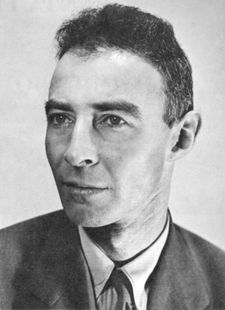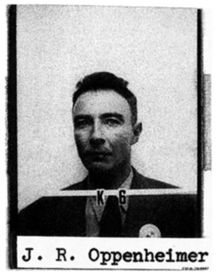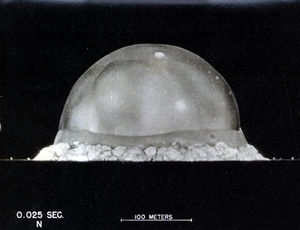Robert Oppenheimer
2007 Schools Wikipedia Selection. Related subjects: Astronomers and physicists
J. Robert Oppenheimer ( April 22, 1904 – February 18, 1967) was an American theoretical physicist, best known for his role as the scientific director of the Manhattan Project, the World War II effort to develop the first nuclear weapons, at the secret Los Alamos laboratory in New Mexico. Known colloquially as " the father of the atomic bomb", Oppenheimer lamented the weapon's killing power after it was used to destroy the Japanese cities of Hiroshima and Nagasaki. After the war, he was a chief advisor to the newly created United States Atomic Energy Commission and used that position to lobby for international control of atomic energy and to avert the nuclear arms race with the Soviet Union. After invoking the ire of many politicians and scientists with his outspoken political opinions during the Red Scare, he had his security clearance revoked in a much-publicized and politicized hearing in 1954. Though stripped of his direct political influence, Oppenheimer continued to lecture, write, and work in physics. A decade later, President John F. Kennedy awarded him the Enrico Fermi Award as a gesture of rehabilitation. As a scientist, Oppenheimer is remembered most for being the chief founder of the American school of theoretical physics while at the University of California, Berkeley.
Early life and education
J. Robert Oppenheimer was born in New York City on April 22, 1904 to Julius S. Oppenheimer (a wealthy textile importer who had immigrated to the United States from Germany in 1888) and Ella Friedman, a painter. Robert had one brother, Frank, eight years younger, who also became a physicist. The Oppenheimers were of Jewish descent but they did not observe the religious traditions.
Robert studied at the Ethical Culture Society School, founded by Felix Adler to promote a form of ethical training based on the Ethical Culture movement. At the school, Robert studied mathematics and science, as well as subjects ranging from Greek to French literature.
Throughout his life, Robert was a versatile scholar, interested in the humanities and in psychotherapy, as well as science. He entered Harvard University one year late due to an attack of colitis. During the interim, he went with a former English teacher to recuperate in New Mexico, where he fell in love with horseback riding and the mountains and plateau of the Southwest. At Harvard, he majored in chemistry, but also studied topics beyond science, including Greek, architecture, classics, art, and literature. He made up for the delay caused by his illness, taking six courses each term and graduating summa cum laude in just three years. When at Harvard, Oppenheimer was admitted to graduate standing in physics in his first year as an undergraduate on the basis of independent study. During a course on thermodynamics taught by Percy Bridgman, Oppenheimer was introduced to experimental physics. In 1933 he learned Sanskrit and met the Indologist Arthur W. Ryder at Berkeley, and read the Bhagavad Gita in the original, citing it later as one of the most influential books to shape his philosophy of life.
Europe
After graduating from Harvard, Oppenheimer was encouraged to go to Europe for future study, as a world-class education in modern physics was not then available in the United States. He was accepted for postgraduate work at Ernest Rutherford's famed Cavendish Laboratory in Cambridge, working under the eminent but aging J.J. Thomson.
Oppenheimer's clumsiness in the laboratory made it apparent that his forte was theoretical, not experimental, physics, so he left in 1926 for the University of Göttingen to study under Max Born. Göttingen was one of the top centers for theoretical physics in the world, and Oppenheimer made a number of friends who would go on to great success, such as Paul Dirac, Wolfgang Pauli, and Werner Heisenberg. At Göttingen, Oppenheimer was known for being a quick study. However, he was also known for being too enthusiastic in discussions, sometimes to the point of taking over seminar sessions, a fact that used to irritate a few of Born's pupils. Oppenheimer obtained his Ph.D. at the young age of 22. After the oral exam for his Ph.D., the professor administering it is reported to have said, "Phew, I'm glad that's over. He was on the point of questioning me."
At Göttingen, Oppenheimer published more than a dozen articles, including many important contributions to the then newly developed quantum theory, most notably a famous paper on the so-called Born-Oppenheimer approximation, which separates nuclear motion from electronic motion in the mathematical treatment of molecules.
Early professional work
In September 1927, Oppenheimer returned to Harvard as a young maven of mathematical physics and a National Research Council Fellow, and in early 1928 he studied at the California Institute of Technology.
While at Caltech he received numerous invitations for teaching positions, and accepted an assistant professorship in physics at the University of California, Berkeley. In his words, "it was a desert", yet paradoxically a fertile place of opportunity. He maintained a joint appointment with Caltech, where he spent every spring term in order to avoid isolation from mainstream research. At Caltech, Oppenheimer struck a close friendship with Linus Pauling and they planned to mount a joint attack on the nature of the chemical bond, a field in which Pauling was a pioneer—apparently Oppenheimer would supply the mathematics and Pauling would interpret the results. However, this collaboration, and their friendship, was nipped in the bud when Pauling began to suspect that the theorist was becoming too close to his wife, Ava Helen . Once when Pauling was at work, Oppenheimer had come to their place and blurted out an invitation to Ava Helen to join him on a tryst in Mexico. She flatly refused and reported this incident to Pauling. This, and her apparent nonchalance about the incident, disquieted him, and he immediately cut off his relationship with the Berkeley professor. Later, Oppenheimer invited Pauling to be the head of the Chemistry Division of the atomic bomb project, but Pauling refused, saying that he was a pacifist.
In the Autumn of 1928, Oppenheimer visited Paul Ehrenfest's institute at the University of Leiden, the Netherlands, where he impressed those there by giving lectures in Dutch despite having little experience with the language. There he was given the nickname of "Opje", which was later Anglicised by his students as "Oppie". From Leiden he continued on to Zurich, Switzerland, to work with Wolfgang Pauli on problems relating to quantum theory and the continuous spectrum, before heading back to the United States. Oppenheimer highly respected and liked Pauli, and some of his own style and his critical approach to problems was said to be inspired by Pauli. During his time with Ehrenfest and Pauli, Oppenheimer polished his mathematical skills.
Before his Berkeley professorship began, Oppenheimer was diagnosed with a mild case of tuberculosis, and with his brother Frank, spent some weeks at a ranch in New Mexico, which he leased and eventually purchased. When he heard the ranch was available for lease, he exclaimed, "Hot dog!"—and later on the name of the ranch became "Perro Caliente" which is the translation of "hot dog" into spanish. Later, Oppenheimer used to say that 'physics and desert country' were his two great loves, loves that would be improbably combined when he directed the atomic bomb project at Los Alamos in New Mexico.
He recovered from his tuberculosis and returned to Berkeley, where he prospered as an advisor and collaborator to a generation of physicists who admired him for his intellectual virtuosity and broad interests. Nobel Prize winner Hans Bethe later said about him:
- Probably the most important ingredient Oppenheimer brought to his teaching was his exquisite taste. He always knew what were the important problems, as shown by his choice of subjects. He truly lived with those problems, struggling for a solution, and he communicated his concern to the group.
He also worked closely with (and became good friends with) Nobel Prize winning experimental physicist Ernest O. Lawrence and his cyclotron pioneers, helping the experimentalists understand the data their machines were producing at the Lawrence's Radiation Laboratory.
Oppenheimer became known as a founding father of the American school of theoretical physics, and developed a reputation for his erudition in physics, his eclecticism, his interest in languages and Eastern philosophy, and the eloquence and clarity with which he thought. But he was also emotionally troubled throughout his life, and professed to experiencing periods of depression. "I need physics more than friends," he once informed his brother. A tall, thin chain smoker who often neglected to eat during periods of intellectual discomfort and concentration, Oppenheimer was marked by many of his friends as having a self-destructive tendency, and during numerous periods of his life worried his colleagues and associates with his melancholy and insecurity. When he was studying in Cambridge and had taken a vacation to meet up with his friend Francis Ferguson in Paris, a disturbing event had taken place. During a conversation in which Oppenheimer was narrating his frustration with experimental physics to Ferguson, he had suddenly leapt up and tried to strangle him. Although Ferguson easily fended off the attack, the episode had convinced Ferguson of his friend's deep psychological troubles. Oppenheimer developed numerous affectations, seemingly in an attempt to convince those around him—or possibly himself—of his self-worth. He was said to be mesmerizing, hypnotic in private interaction but often frigid in more public settings. His associates fell into two camps: one which saw him as an aloof and impressive genius and an aesthete; another which saw him as a pretentious and insecure poseur. His students almost always fell into the former category, adopting "Oppie's" affectations, from his way of walking to talking and beyond — even trying to replicate his inclination for reading entire texts in their originally transcribed languages.
Scientific work
Oppenheimer did important research in theoretical astrophysics (especially as it relates to general relativity and nuclear theory), nuclear physics, spectroscopy, and quantum field theory (including its extension into quantum electrodynamics). The formalism of relativistic quantum mechanics also attracted his attention, although because of the then existing well-known problem of the self-energy of the electron, he doubted the validity of quantum electrodynamics at high energies. His best-known contribution, made as a graduate student, is the Born-Oppenheimer approximation mentioned above. He also made important contributions to the theory of cosmic ray showers, and did work which eventually led toward descriptions of quantum tunneling. His work on the Oppenheimer-Phillips process, involved in artificial radioactivity under bombardment by deuterons, has served as an important step in nuclear physics. In the late 1930s, he was the first to write papers suggesting the existence of what we today call black holes. In these papers, he demonstrated that there was a size limit (the so called Tolman-Oppenheimer-Volkoff limit) to stars beyond which they would not remain stable as neutron stars, and would undergo gravitational collapse. After the Born-Oppenheimer approximation paper, these papers remain his most cited ones, and they were key in the rejuvenation of astrophysical research in the United States in the 1950s, mainly by John Wheeler. As early as 1930, he also wrote a paper essentially predicting the existence of the positron (which had been postulated by Paul Dirac), a formulation that he however did not carry to its natural outcome, because of his skepticism about the validity of the Dirac equation. As evidenced above, his work predicts many later finds which include, further, the neutron, meson, and neutron star. Even beyond the immense abstruseness of the topics he was expert in, Oppenheimer's papers were considered difficult to understand. Oppenheimer was very fond of using elegant, if extremely complex, mathematical techniques to demonstrate physical principles, though he was sometimes criticized for making mathematical mistakes, presumably out of haste.
Many people thought that Oppenheimer's discoveries and research were not commensurate with his inherent abilities and talents. They still considered him an outstanding physicist, but they did not place him at the very top rank of theorists who fundamentally challenged the frontiers of knowledge. One reason for this could have been his diverse interests, which kept him from completely focusing on any individual topic for long enough to bring it to full fruition. His close confidant and colleague, Nobel Prize winner Isidor Rabi, later gave his own interpretation:
- Oppenheimer was overeducated in those fields which lie outside the scientific tradition, such as his interest in religion, in the Hindu religion in particular, which resulted in a feeling of mystery of the universe that surrounded him like a fog. He saw physics clearly, looking toward what had already been done, but at the border he tended to feel there was much more of the mysterious and novel than there actually was...[he turned] away from the hard, crude methods of theoretical physics into a mystical realm of broad intuition.
In spite of this, some people (such as the Nobel Prize winner physicist Luis Alvarez) have suggested that if he had lived long enough to see his predictions substantiated by experiment, Oppenheimer might have won a Nobel Prize for his work on gravitational collapse, concerning neutron stars and black holes. Interestingly, when the physicist and historian Abraham Pais once asked Oppenheimer about what he considered to be his most important scientific contributions, Oppenheimer cited his work on electrons and positrons, but did not mention anything about his work on gravitational contraction.
Radical politics
During the 1920s, Oppenheimer kept himself aloof of worldly matters, and claimed to have not learned of the Stock Market Crash of 1929 until some time after the fact (Oppenheimer himself had little worry regarding financial matters, as his family supported him amply). It was not until he became involved with Jean Tatlock, the daughter of a Berkeley literature professor, in 1936, that he showed any interest in politics. Like many young intellectuals in the 1930s he became a supporter of communist ideas. After inheriting over $300,000 upon his father's death in 1937, he donated to many left-wing efforts. The majority of his radical work consisted of hosting fund-raisers for the Republican cause in the Spanish Civil War and other anti-fascist activity. He never openly joined the Communist Party, though he did pass money to liberal causes by way of Party members. Historian Gregg Herken has recently claimed to have evidence that Oppenheimer did interact with the Communist Party during the 1930s and early 1940s.
Robert's brother, Frank, and some of his graduate students were Party members at different times.
Marriage and family life
In November 1940, he married Katherine ("Kitty") Puening Harrison, a radical Berkeley student and former Communist Party member. Katherine had been married twice previously, first to Joe Dallet, a Communist Party and union activist who was killed in the Spanish civil war. She divorced her second husband, a southern California doctor, to marry Oppenheimer.
By May 1941 they had their first child, Peter. Their second child, Katherine (called Toni), was born in 1944, while Oppenheimer was scientific director of the Manhattan Project.
During his marriage, Oppenheimer continued his involvement with Jean Tatlock, though it is not clear if they continued their love affair. Later their continued contact became an issue in Oppenheimer's security clearance hearings, due to Tatlock's communist associations.
The Manhattan Project
When World War II started, Oppenheimer became involved in the efforts to develop an atomic bomb which were already taking up much of the time and facilities of Lawrence's Radiation Laboratory at Berkeley. In 1941, Lawrence, Vannevar Bush, Arthur Compton, and James Conant worked to wrest the bomb project from the S-1 Uranium Committee, because they felt it was proceeding too slowly. Oppenheimer was invited to take over work on fast neutron calculations, a task which he threw himself into with full vigor. At this time he renounced what he called his "left-wing wanderings" to concentrate on his responsibilities, though he continued to maintain friendships with many who were quite radical.
In 1942, the U.S. Army was given jurisdiction over the bomb effort, which was renamed as the Manhattan Engineering District, or Manhattan Project. General Leslie R. Groves was appointed project director, and Groves, in turn, selected Oppenheimer as the project's scientific director. Groves knew of Oppenheimer would be viewed as a security risk, but thought that Oppenheimer was the best man to direct a diverse team of scientists and would be unaffected by his past political leanings.
Los Alamos
One of Oppenheimer's first acts was to host a summer school for bomb theory at his building in Berkeley. The mix of European physicists and his own students—a group including Robert Serber, Emil Konopinski, Felix Bloch, Hans Bethe, and Edward Teller—busied themselves calculating what needed to be done, and in what order, to make the bomb. When Teller put forward the remote possibility that the bomb would generate enough heat to ignite the atmosphere (an event that was soon shown to be impossible by Bethe), Oppenheimer nevertheless was concerned enough to meet up with Arthur Compton in Michigan to discuss the situation. At the time, research for the project was going on at many different universities and laboratories across the country, presenting a problem for both security and cohesion. Oppenheimer and Groves decided that they needed a centralized, secret research laboratory. Scouting for a site, Oppenheimer was drawn to New Mexico, not far from his ranch. On a flat mesa near Santa Fe, New Mexico, the Los Alamos laboratory was hastily built on the site of a private boys school. There Oppenheimer assembled a group of physicists, which he referred to as the "luminaries", including Enrico Fermi, Richard Feynman, Robert R. Wilson, and Victor Weisskopf, as well as Bethe and Teller.
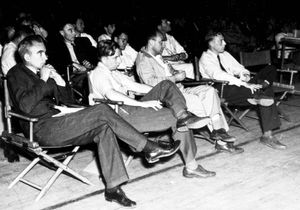
Oppenheimer was noted for his mastery of all scientific aspects of the project and for his efforts to control the inevitable cultural conflicts between scientists and the military. He was an iconic figure to his fellow scientists, as much a figurehead of what they were working towards as a scientific director. Victor Weisskopf put it thus:
- "He did not direct from the head office. He was intellectually and even physically present at each decisive step. He was present in the laboratory or in the seminar rooms, when a new effect was measured, when a new idea was conceived. It was not that he contributed so many ideas or suggestions; he did so sometimes, but his main influence came from something else. It was his continuous and intense presence, which produced a sense of direct participation in all of us; it created that unique atmosphere of enthusiasm and challenge that pervaded the place throughout its time."
All the while, Oppenheimer was under investigation by both the FBI and the Manhattan Project's internal security arm for his past left-wing associations. He was also followed by an FBI agent during an unannounced trip to California in 1943 to meet his former girlfriend, Jean Tatlock. In August 1943, Oppenheimer told Manhattan Project security agents that three of his students had been solicited for nuclear secrets by a friend of his with Communist connections. When pressed on the issue in later interviews with General Groves and security agents, he identified the friend as Haakon Chevalier, a Berkeley professor of French literature. Oppenheimer would be asked for interviews related to the "Chevalier incident", and he often gave contradictory and equivocating statements, telling Groves that only one person had actually been approached, and that person was his brother Frank. But Groves still thought Oppenheimer too important to the ultimate Allied goals to oust him over this suspicious behaviour.
Trinity
The joint work of the scientists at Los Alamos resulted in the first nuclear explosion near Alamogordo on July 16, 1945, the site of which Oppenheimer named "Trinity", Oppenheimer later said this name was from one of John Donne's Holy Sonnets. According to the historian Gregg Herken, this naming could have been an allusion to Jean Tatlock (who had introduced him to Donne when they had dated in the 1930s), who had committed suicide a few months previously. He later recalled that while witnessing the explosion he thought of a verse from the Hindu holy book, the Bhagavad Gita:
- If the radiance of a thousand suns were to burst at once into the sky, that would be like the splendor of the mighty one...
Years later he would explain that another verse had also entered his head at that time:
- "We knew the world would not be the same. A few people laughed, a few people cried, most people were silent. I remembered the line from the Hindu scripture, the Bhagavad-Gita. Vishnu is trying to persuade the Prince that he should do his duty and to impress him takes on his multi-armed form and says, 'Now, I am become Death, the destroyer of worlds.' I suppose we all thought that one way or another."
According to his brother, at the time he simply exclaimed, "It worked." News of the successful test was rushed to President Harry S. Truman, who authorized the atomic bombings of Hiroshima and Nagasaki, Japan. Oppenheimer later became an important figure in the debates on the repercussions of this act.
Postwar activities
Overnight, Oppenheimer became a national spokesman for science, and emblematic of a new type of technocratic power. Nuclear physics became a powerful force as all governments of the world began to realize the strategic and political power which came with nuclear weapons and their horrific implications. Like many scientists of his generation, he felt that security from atomic bombs would come only from some form of transnational organization (such as the newly formed United Nations) which could institute a program to stifle a nuclear arms race.
Atomic Energy Commission
After the Atomic Energy Commission (AEC) was created in 1946, as a civilian agency in control of nuclear research and weapons issues, Oppenheimer was immediately appointed as the Chairman of its General Advisory Committee (GAC) and left the directorship of Los Alamos. From this position he advised on a number of nuclear-related issues, including project funding, laboratory construction, and even international policy—though the GAC's advice was not always implemented.
As a member of the Board of Consultants to a committee appointed by President Truman to advise the United Nations Atomic Energy Commission, Oppenheimer strongly influenced the Acheson-Lilienthal Report,. In this report, the committee advocated creation of an international Atomic Development Authority, which would own all fissionable material, and the means of its production, such as mines and laboratories, and atomic power plants where it could be used for peaceful energy production. Bernard Baruch was appointed to translate this report into a proposal to the United Nations, resulting in the Baruch Plan of 1946. The Baruch Plan introduced many additional provisions regarding enforcement, in particular requiring inspection of the USSR's uranium resources. The Baruch Plan was seen as an attempt to maintain the United States' nuclear monopoly, and was rejected by the USSR. With this, it became clear to Oppenheimer that an arms race was unavoidable, due to the mutual distrust of the U.S. and the USSR.
While still Chairman of the GAC, Oppenheimer lobbied vigorously for international arms control and funding for basic science, and attempted to influence policy away from a heated arms race. When the government questioned whether to pursue a crash program to develop an atomic weapon based on nuclear fusion—the hydrogen bomb—Oppenheimer initially recommended against it, though he had been in favour of developing such a weapon in the early days of the Manhattan Project. He was motivated partly by ethical concerns, feeling that such a weapon could only be used strategically against civilian targets, resulting in millions of deaths. But he was also motivated by practical concerns; as at the time there was no workable design for a hydrogen bomb, Oppenheimer felt that resources would be better spent creating a large force of fission weapons; he and others were especially concerned about nuclear reactors being diverted away from producing plutonium to produce tritium. He was overridden by President Harry Truman, who announced a crash program after the Soviet Union tested their first atomic bomb in 1949. Oppenheimer and other GAC opponents of the project, especially James Conant, felt personally shunned and considered retiring from the committee. They stayed on, though their views on the hydrogen bomb were well known.
In 1951, however, Edward Teller and mathematician Stanislaw Ulam developed what became known as the Teller-Ulam design for a hydrogen bomb. This new design seemed technically feasible, and Oppenheimer changed his opinion about developing the weapon. As he later recalled:
- The program we had in 1949 was a tortured thing that you could well argue did not make a great deal of technical sense. It was therefore possible to argue that you did not want it even if you could have it. The program in 1951 was technically so sweet that you could not argue about that. The issues became purely the military, the political, and the humane problems of what you were going to do about it once you had it.
Oppenheimer's critics have accused him of equivocating between 1949, when he opposed the development of the hydrogen bomb, and 1951, when he supported it. Some have made this a case for reinforcing their opinions about his moral inconsistency. Historian Priscilla McMillan has argued, however, that if Oppenheimer has been accused of being morally inconsistent, then so should Rabi and Fermi, who had also opposed the program in 1949. Most of the GAC members were against a crash hydrogen bomb development program then, and in fact, Conant, Fermi and Rabi had submitted even more strongly worded reports against it than Oppenheimer. McMillan's argument is that because the hydrogen bomb appeared to be well within reach in 1951, everybody had to assume that the Russians could also do it, and that was the main reason why they changed their stance in favour of developing it. Thus this change in opinion should not be viewed as a change in morality, but a change in opinions purely based on technical possibilities.
The first true hydrogen bomb, dubbed " Ivy Mike", was tested in 1952 with a yield of 10.4 megatons, more than 650 times the strength of the weapons developed by Oppenheimer during World War II.
Security hearings
In his role as a political advisor, Oppenheimer made numerous enemies. The FBI under J. Edgar Hoover had been following his activities since before the war, when he showed Communist sympathies as a radical professor. They were willing to furnish Oppenheimer's political enemies with incriminating evidence about Communist ties. These enemies included Lewis Strauss, an AEC commissioner who had long harbored resentment against Oppenheimer both for his activity in opposing the hydrogen bomb and for his humiliation of Strauss before Congress some years earlier, regarding Strauss's opposition to the export of radioactive isotopes to other nations. Strauss and Senator Brien McMahon, author of the 1946 Atomic Energy Act, pushed President Eisenhower to revoke Oppenheimer's security clearance. This came following controversies about whether some of Oppenheimer's students, including David Bohm, Joseph Weinberg, and Bernard Peters, had been Communists at the time they had worked with him at Berkeley. Oppenheimer's brother, Frank Oppenheimer, was forced to testify in front of the House Un-American Activities Committee, where he admitted that he had been a member of the Communist Party in the 1930s, but he refused to name other members. Frank was subsequently fired from his university position, could not find work in physics, and became instead a cattle rancher in Colorado, and later the founder of the San Francisco Exploratorium.
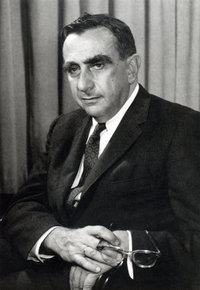
In 1953, Oppenheimer was accused of being a security risk and President Dwight D. Eisenhower asked him to resign. Oppenheimer refused and requested a hearing to assess his loyalty, and in the meantime his security clearance was suspended. The public hearing which followed focused on Oppenheimer's past Communist ties and his association during the Manhattan Project with suspected disloyal or Communist scientists. One of the key elements in this hearing was Oppenheimer's earlier testimony about his friend Haakon Chevalier, something which he himself confessed he had fabricated. In fact, Oppenheimer had never told Chevalier about this, and the testimony had led to Chevalier losing his job. Edward Teller, with whom Oppenheimer had disagreed on the hydrogen bomb, testified against him, leading to outrage by the scientific community and Teller's virtual expulsion from academic science. Many top scientists, as well as government and military figures, testified on Oppenheimer's behalf. Inconsistencies in his testimony and his erratic behaviour on the stand convinced some that he was unreliable and a possible security risk. Oppenheimer's clearance was revoked.
During his hearing, Oppenheimer testified willingly on the left-wing behaviour of many of his scientific colleagues. Cornell University historian Richard Polenberg has speculated that if Oppenheimer's clearance had not been stripped (it would have expired in a matter of days anyhow), he would have been remembered as someone who had "named names" to save his own reputation. As it happened, Oppenheimer was seen by most of the scientific community as a martyr to McCarthyism, an eclectic liberal who was unjustly attacked by warmongering enemies, symbolic of the shift of scientific creativity from academia into the military. Werner von Braun summed up his opinion about the matter by saying, "If this were England, Oppenheimer would have been knighted".
Institute for Advanced Study
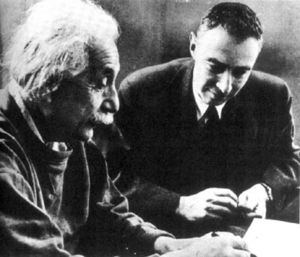
In 1947, Oppenheimer left Berkeley, citing difficulties with the administration during the war, and took up the directorship of the Institute for Advanced Study at Princeton, New Jersey. He later held Albert Einstein's old position of senior professor of theoretical physics.
After 1953, deprived of political power, Oppenheimer continued to lecture, write, and work on physics. He toured Europe and Japan, giving talks about the history of science, the role of science in society, and the nature of the universe. On 3 May 1962 he was elected a Fellow of the Royal Society. In 1963, at the urging of many of Oppenheimer's political friends who had ascended to power, President John F. Kennedy awarded Oppenheimer the Enrico Fermi Award as a gesture of political rehabilitation. Edward Teller, the winner of the previous year's award, had also recommended Oppenheimer receive it. A little over a week after Kennedy's assassination, his successor, President Lyndon Johnson, presented Oppenheimer with the award, "for contributions to theoretical physics as a teacher and originator of ideas, and for leadership of the Los Alamos Laboratory and the atomic energy program during critical years". Oppenheimer told Johnson: "I think it is just possible, Mr. President, that it has taken some charity and some courage for you to make this award today." The rehabilitation implied by the award was only symbolic, as Oppenheimer still lacked a security clearance and could have no effect on official policy, but the award came with a $50,000 stipend.
In his final years, Oppenheimer continued his work at the Institute for Advanced Study, bringing together intellectuals at the height of their powers and from a variety of disciplines to solve the most pertinent questions of the current age. He directed and encouraged the research of many well-known scientists, including Freeman Dyson, and the duo of Yang and Lee, who won a Nobel Prize for their discovery of parity non-conservation. He also instituted temporary memberships for scholars from the humanities, such as T. S. Eliot and George Kennan. Some of these activities were resented by a few members of the mathematics faculty, who wanted the institute to stay a bastion of pure scientific research. Abraham Pais says that Oppenheimer himself thought that one of his failures at the institute was a failure to bring together scholars from the natural sciences and the humanities. Oppenheimer's lectures in America, Europe, and Canada were published in a number of books. Still, he thought the effort had minimal effect on actual policy.
Final years
After the 1954 Security hearings, Oppenheimer is reported to have been "like a wounded animal", and he started to retreat to a simpler life. In 1957, he purchased a piece of land on Gibney Beach in the island of St John in the Virgin Islands. He built a spartan vacation home on the beach, where he would spend holidays, usually months at a time, with his wife Kitty. Oppenheimer also spent a considerable amount of time sailing with his wife. Upon their death, the property was inherited by their daughter Toni, who then left it to "the people of St. John for a public park and recreation area." Today, the Virgin Islands Government maintains a Community Centre there, which can be rented out. The northern portion of the beach is colloquially known to this day as "Oppenheimer Beach".
Robert Oppenheimer died of throat cancer in Princeton, New Jersey, in 1967. His funeral was attended by many of his scientific, political, and military associates, and eulogies were delivered by Hans Bethe and George F. Kennan among others. His ashes were spread over the Virgin Islands.
Legacy
Robert Oppenheimer's life is usually seen to highlight a number of cultural and historical trends in the transformation of science from the 1920s through the 1950s.
As a scientist, Oppenheimer is remembered by his students and colleagues as being a brilliant researcher and engaging teacher, the founder of modern theoretical physics in the United States. Many have asked why Oppenheimer never won a Nobel Prize. Scholars respond that his scientific attentions often changed rapidly and he never worked long enough on any one topic to achieve enough headway to merit the Nobel Prize. His lack of a Prize would not be odd—most scientists do not win Nobel Prizes—had not so many of his associates (Einstein, Fermi, Bethe, Lawrence, Dirac, Rabi, Feynman, etc.) won them. Some scientists and historians have speculated that his investigations towards black holes may have warranted the Nobel, had he lived long enough to see them brought into fruition by later astrophysicists.
As a military and public policy advisor, Oppenheimer was a technocratic leader in a shift in the interactions between science and the military and the emergence of " Big Science." During World War II, scientists became involved in military research to an unprecedented degree (some research of this sort had occurred during World War I, but it was far smaller in scope). Because of the threat Fascism posed to Western civilization, scientists volunteered in great numbers both for technological and organizational assistance to the Allied effort, resulting in such powerful tools as radar, the proximity fuze, and operations research. As a cultured, intellectual, theoretical physicist who became a disciplined military organizer, Oppenheimer represented the shift away from the idea that scientists had their "head in the clouds" and that knowledge on such previously esoteric subjects as the composition of the atomic nucleus had no "real-world" applications.
When Oppenheimer was ejected from his position of political influence in 1954, he symbolized for many the folly of scientists thinking they could control how others would use their research. Oppenheimer has been seen as symbolizing the dilemmas involving the moral responsibility of the scientist in the nuclear world.
Most popular depictions of Oppenheimer view his security struggles as a confrontation between right-wing militarists (symbolized by Edward Teller) and left-wing intellectuals (symbolized by Oppenheimer) over the moral question of weapons of mass destruction. Many historians have contested this as an over-simplification. The hearings were motivated both by politics, as Oppenheimer was seen as a representative of the previous administration, and also by personal considerations stemming from his enmity with Lewis Strauss. Furthermore, the ostensible reason for the hearing and the issue that aligned Oppenheimer with the liberal intellectuals, Oppenheimer's opposition to hydrogen bomb development, was based as much on technical grounds as on moral ones. Once the technical considerations were resolved, he supported "the Super", because he believed that the Soviet Union too would inevitably construct one. Nevertheless, the trope of Oppenheimer as a martyr has proven indelible, and to speak of Oppenheimer has often been to speak of the limits of science and politics, however more complicated the actual history.
One particular example of the view of Oppenheimer as martyr is found in German playwright Heinar Kipphardt's 1964 play, In the Matter J. Robert Oppenheimer. Even Oppenheimer himself had difficulty with this portrayal—after reading a transcript of Kipphardt's play soon after it began to be performed, Oppenheimer threatened to sue the playwright. Later he told an interviewer:
- The whole damn thing [his security hearing] was a farce, and these people are trying to make a tragedy out of it. ... I had never said that I had regretted participating in a responsible way in the making of the bomb. I said that perhaps he [Kipphardt] had forgotten Guernica, Coventry, Hamburg, Dresden, Dachau, Warsaw, and Tokyo; but I had not, and that if he found it so difficult to understand, he should write a play about something else.
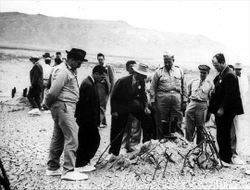
Despite Oppenheimer's remorseful, or at least conflicted, attitudes, Oppenheimer was a vocal supporter of using the first atomic weapons on "built-up areas" in the days before the bombings of Hiroshima and Nagasaki. Rather than consistently opposing the "Red-baiting" of the late 1940s and early 1950s, he had testified against many of his former colleagues and students, both before and during his hearing. In one incident, Oppenheimer's damning testimony against former student Bernard Peters was selectively leaked to the press. Historians have interpreted this as an attempt by Oppenheimer to please his colleagues in the government (and perhaps to avert attention from his own previous left-wing ties and especially from those of his brother, who had earlier been a target of the anti-Red lobby). In the end it became a liability: under cross-examination, it became clear that if Oppenheimer had really doubted Peters' loyalty, then his recommending him for the Manhattan Project was reckless, or at least contradictory.
The question of the scientists' responsibility towards humanity, so manifest in the dropping of the atomic bombs and Oppenheimer's public questioning, in addition to Kipphardt's play, inspired Bertolt Brecht's drama Galileo (from 1955), left its imprint on Friedrich Dürrenmatt's Die Physiker, and is the basis of the opera Doctor Atomic, which portrays Oppenheimer as a modern Faustus.
